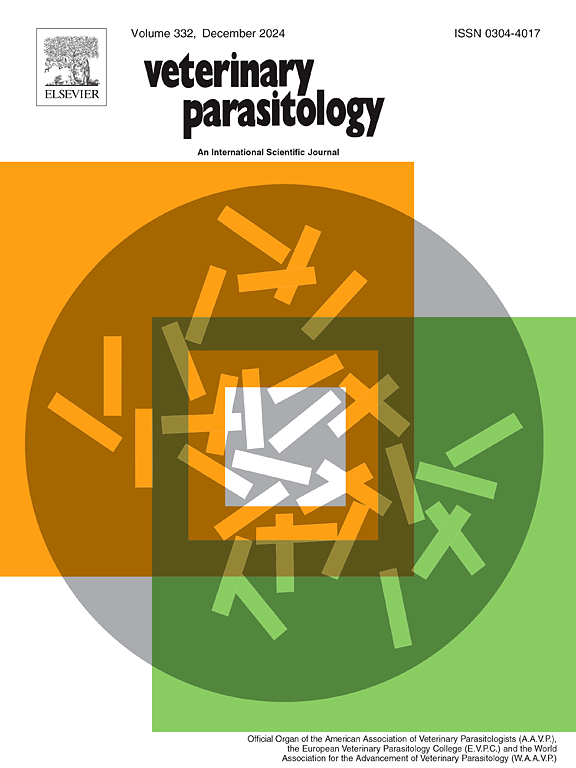Systematic review on buparvaquone resistance associated with non-synonymous mutation in drug binding genes site of Theileria annulate
IF 2
2区 农林科学
Q2 PARASITOLOGY
引用次数: 0
Abstract
Theileria annulata (T. annulata) is intra-erythrocytic protozoan parasite which is more prevalent in tropical and sub-tropical countries. It has a significant economic impact on the productivity of the dairy industry, and buparvaquone is used to treat infected animals in the prevalent regions of the world. Systematically, buparvaquone targets the cyto-b gene to break the electron transport chain (ETC) and Theileria annulata peptidyl-prolyl isomerase 1 (TaPIN1) gene to destabilize transcription factor JUN (c-JUN) to inhibit proliferation of infected cells, which ultimately leads to the death of T. annulata. The reported studies on drug resistance is due to inappropriate drug application, evolutionary characteristics of the cytochrome b (cyto-b) gene and oncogenic signaling pathways gene (TaPIN1) make the parasite resistant against buparvaquone. Hence, this systematic review was designed to find out non-synonymous mutation in genes (cyto-b and TaPIN1) responsible for drug resistance reported from Tunisia, Turkey, Egypt, Sudan, Iran, Pakistan, China and Germany with reference to the T. annulata Ankara strain of cyto-b (accession no. XM_949625.1) and TaPIN1 (accession no. TA18945) wild type genes. Non-synonymous point mutations were found in cyto-b (Q01 at 130–148 and Q02 at 253–262 regions) and TaPIN1 (A53P and A53T) genes. These point mutations are responsible for developing buparvaquone resistance against T. annulata infection. These genes can be used as biomarkers for the identification of drug resistance in any endemic area. To avoid the complication of drug resistance, development of genetically resistant cattle breeds, potent vaccines and anti-theilerial drugs (Trifloxystrobin and anti-cancerous) are currently required to control proliferating economically important T. annulata parasites.
与环斑蓟马药物结合基因位点非同义突变相关的布帕伐醌抗药性系统综述
环状丝虫(T. annulata)是一种红细胞内原生动物寄生虫,在热带和亚热带国家较为流行。这种寄生虫对奶牛业的生产率有着重大的经济影响,布帕伐醌(buparvaquone)被用于治疗全球流行地区受感染的动物。布帕伐醌系统性地以 cyto-b 基因为靶点,破坏电子传递链(ETC)和环状毛癣菌肽基脯氨酰异构酶 1(TaPIN1)基因,从而破坏转录因子 JUN(c-JUN)的稳定性,抑制感染细胞的增殖,最终导致环状毛癣菌死亡。有关耐药性的研究报告指出,由于用药不当,细胞色素 b(cyto-b)基因和致癌信号通路基因(TaPIN1)的进化特性使寄生虫对布帕伐醌产生了耐药性。因此,本系统综述旨在找出突尼斯、土耳其、埃及、苏丹、伊朗、巴基斯坦、中国和德国等国报道的导致耐药性的基因(cyto-b 和 TaPIN1)的非同义突变,并参考了安卡拉锚头蚴菌株的 cyto-b(登录号:XM_949625.1)和 TaPIN1(登录号:TA18945)野生型基因。在 cyto-b(130-148 区域的 Q01 和 253-262 区域的 Q02)和 TaPIN1(A53P 和 A53T)基因中发现了非同义点突变。这些点突变是布帕伐醌对环斑驳虫感染产生抗性的原因。这些基因可作为生物标志物,用于识别任何流行地区的抗药性。为避免耐药性带来的并发症,目前需要开发具有基因抗性的牛种、强效疫苗和抗尾蚴药物(三氟士的宁和抗癌药),以控制不断增殖的具有重要经济价值的环尾丝虫病寄生虫。
本文章由计算机程序翻译,如有差异,请以英文原文为准。
求助全文
约1分钟内获得全文
求助全文
来源期刊

Veterinary parasitology
农林科学-寄生虫学
CiteScore
5.30
自引率
7.70%
发文量
126
审稿时长
36 days
期刊介绍:
The journal Veterinary Parasitology has an open access mirror journal,Veterinary Parasitology: X, sharing the same aims and scope, editorial team, submission system and rigorous peer review.
This journal is concerned with those aspects of helminthology, protozoology and entomology which are of interest to animal health investigators, veterinary practitioners and others with a special interest in parasitology. Papers of the highest quality dealing with all aspects of disease prevention, pathology, treatment, epidemiology, and control of parasites in all domesticated animals, fall within the scope of the journal. Papers of geographically limited (local) interest which are not of interest to an international audience will not be accepted. Authors who submit papers based on local data will need to indicate why their paper is relevant to a broader readership.
Parasitological studies on laboratory animals fall within the scope of the journal only if they provide a reasonably close model of a disease of domestic animals. Additionally the journal will consider papers relating to wildlife species where they may act as disease reservoirs to domestic animals, or as a zoonotic reservoir. Case studies considered to be unique or of specific interest to the journal, will also be considered on occasions at the Editors'' discretion. Papers dealing exclusively with the taxonomy of parasites do not fall within the scope of the journal.
 求助内容:
求助内容: 应助结果提醒方式:
应助结果提醒方式:


